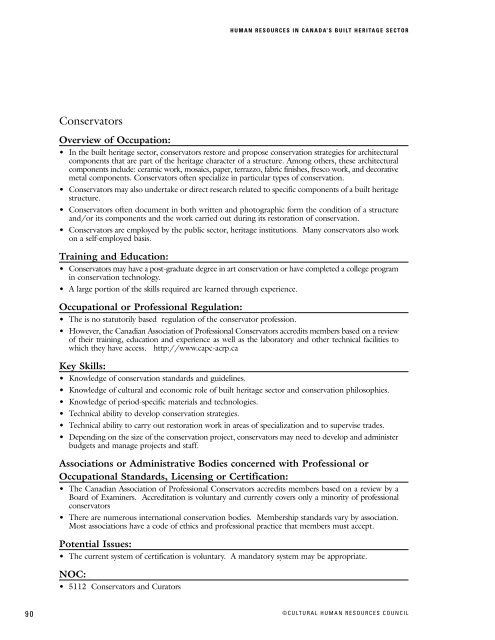Human Resources in Canada's Built Heritage Sector: Mapping the ...
Human Resources in Canada's Built Heritage Sector: Mapping the ...
Human Resources in Canada's Built Heritage Sector: Mapping the ...
- No tags were found...
You also want an ePaper? Increase the reach of your titles
YUMPU automatically turns print PDFs into web optimized ePapers that Google loves.
HUMAN RESOURCES IN CANADA’S BUILT HERITAGE SECTORConservatorsOverview of Occupation:• In <strong>the</strong> built heritage sector, conservators restore and propose conservation strategies for architecturalcomponents that are part of <strong>the</strong> heritage character of a structure. Among o<strong>the</strong>rs, <strong>the</strong>se architecturalcomponents <strong>in</strong>clude: ceramic work, mosaics, paper, terrazzo, fabric f<strong>in</strong>ishes, fresco work, and decorativemetal components. Conservators often specialize <strong>in</strong> particular types of conservation.• Conservators may also undertake or direct research related to specific components of a built heritagestructure.• Conservators often document <strong>in</strong> both written and photographic form <strong>the</strong> condition of a structureand/or its components and <strong>the</strong> work carried out dur<strong>in</strong>g its restoration of conservation.• Conservators are employed by <strong>the</strong> public sector, heritage <strong>in</strong>stitutions. Many conservators also workon a self-employed basis.Tra<strong>in</strong><strong>in</strong>g and Education:• Conservators may have a post-graduate degree <strong>in</strong> art conservation or have completed a college program<strong>in</strong> conservation technology.• A large portion of <strong>the</strong> skills required are learned through experience.Occupational or Professional Regulation:• The is no statutorily based regulation of <strong>the</strong> conservator profession.• However, <strong>the</strong> Canadian Association of Professional Conservators accredits members based on a reviewof <strong>the</strong>ir tra<strong>in</strong><strong>in</strong>g, education and experience as well as <strong>the</strong> laboratory and o<strong>the</strong>r technical facilities towhich <strong>the</strong>y have access. http://www.capc-acrp.caKey Skills:• Knowledge of conservation standards and guidel<strong>in</strong>es.• Knowledge of cultural and economic role of built heritage sector and conservation philosophies.• Knowledge of period-specific materials and technologies.• Technical ability to develop conservation strategies.• Technical ability to carry out restoration work <strong>in</strong> areas of specialization and to supervise trades.• Depend<strong>in</strong>g on <strong>the</strong> size of <strong>the</strong> conservation project, conservators may need to develop and adm<strong>in</strong>isterbudgets and manage projects and staff.Associations or Adm<strong>in</strong>istrative Bodies concerned with Professional orOccupational Standards, Licens<strong>in</strong>g or Certification:• The Canadian Association of Professional Conservators accredits members based on a review by aBoard of Exam<strong>in</strong>ers. Accreditation is voluntary and currently covers only a m<strong>in</strong>ority of professionalconservators• There are numerous <strong>in</strong>ternational conservation bodies. Membership standards vary by association.Most associations have a code of ethics and professional practice that members must accept.Potential Issues:• The current system of certification is voluntary. A mandatory system may be appropriate.NOC:• 5112 Conservators and Curators90©CULTURAL HUMAN RESOURCES COUNCIL










